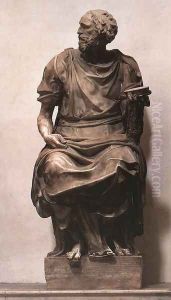Raffaello da Montelupo Paintings
Raffaello da Montelupo was an Italian sculptor and architect of the Renaissance period, born around 1505 in Montelupo Fiorentino, a small town near Florence, Italy. His full name was Raffaello Sinibaldi, but he is commonly known by the name of his hometown. Raffaello was the son of another sculptor, Baccio da Montelupo, and was trained by his father in the art of sculpture.
Raffaello's early career was influenced by the prevailing styles of the time, including the works of Michelangelo and Andrea Sansovino. He worked on various projects in Rome, where he contributed to the embellishment of important buildings and was involved in the creation of several significant sculptures. Among his most recognized works from this period are the statues he created for the Cappella Paolina in the Vatican, as well as his contributions to the fortifications of the Castel Sant'Angelo in Rome.
In addition to his sculptural work, Raffaello da Montelupo also had an interest in architecture. He was involved in the construction and design of fortifications, which was a significant aspect of Italian Renaissance architecture, reflecting the period's preoccupation with military defense and urban planning.
Despite working in the shadow of more famous contemporaries like Michelangelo, Raffaello managed to carve out a career for himself and was esteemed by his patrons. His style was characterized by a blend of grace and strength, and he was adept at conveying the human form with a sense of dignity and serenity. His works are considered to be representative of the transition between the High Renaissance and Mannerist styles.
Raffaello da Montelupo's career eventually waned, and he died in relative obscurity around 1566-1567. Nonetheless, his contributions to Renaissance art, particularly sculpture, have been recognized by art historians, and his works can still be admired in various Italian cities, including Rome and Florence.
